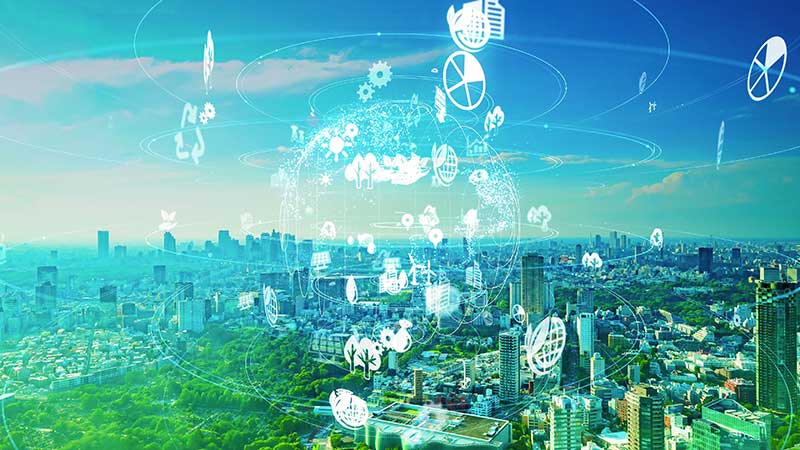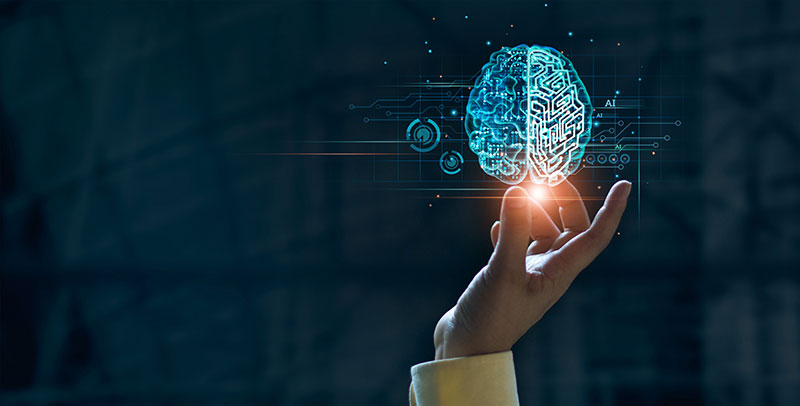Two years into the global pandemic, it often feels as though we don’t have much say in how the world is changing. We’re responding to new variants, adjusting to new social norms, and worrying about what’s around the corner. But technology is changing fast, too, and we do have a say in which emerging solutions will best confront the unique challenges of our century.
At SADA, we spend all day immersed in technologies that are on the horizon. We speculate, prognosticate, and accelerate the growth of tools and instruments that were science fiction mere years ago. Fact is, we love technology and geek out on it endlessly. So it’s with great pleasure that we offer SADA’s vision for the five tech trends that are most worth paying attention to in 2022.
1. Geospatial data: moving beyond maps

Remember how quickly Google Maps and Google Earth became a part of our lives? Now, maps are for much more than simply charting one’s route from point A to point B. Geospatial data is opening up entirely new industries and empowering legacy businesses with new opportunities.
“What’s been really interesting as of late is seeing the economics, performance, and ease of use and development finally hit that point where vast amounts of geospatial information can be generated, stored, and analyzed incredibly quickly,” says SADA Associate CTO Brian Suk, “These ideas aren’t new, but they’ve been relegated to science fiction for quite some time. What’s different is that all this is now available at our fingertips, and with data at scale underpinning all this, organizations are figuring out how to take advantage of this power. I think this phase of the industry is just really getting into gear, and will be interesting to see where it goes.”
At SADA, we’re excited about helping businesses use geospatial data to develop inventive, new solutions. For instance, Google Cloud Platform (GCP) provides an excellent environment for innovating with Geographical Information Systems (GIS), Light Detection and Ranging (LiDAR), and Internet of Things (IoT) data. Here are just a few ways businesses that rely on earth data are getting the most from the cloud.
LiDAR data visualization
LiDAR data can be used to create 3D models of buildings, roads, and other features. It’s a great way to gain insight into the physical environment around you. LiDAR sensors use laser pulses to measure distances between the sensor and objects in its path. We’ve found GCP ideal for working with LiDAR data because it supports large datasets that are common to these sorts of expansive projects. It also allows users to quickly deploy applications, with Google BigQuery proving especially capable of analyzing billions of rows of geospatial data in mere minutes.
GIS analysis & visualization
GIS provides interactive maps based on location-based information such as streets, schools, hospitals, and natural resources, which makes it useful for everything from civil engineering to wildlife conservation. GIS is even becoming more prominent in the world of video games. Remember how Pokemon Go made such a splash a few years ago? That was just the beginning for the integration of GIS and games. We’ve noticed some incredibly cool solutions in this space; check out the use of wildlife migration data in games developed by Kenya-based studio Internet of Elephants.
IoT data visualization
IoT is a term used to describe the growing number of everyday objects that are connected to the Internet, which allows them to send and receive data from other devices or applications. As more devices become connected, it will be increasingly important for businesses to develop ways to make sense of all this data to gain insights into their operations. GCP provides some excellent tools for analyzing IoT data, including BigQuery, Cloud Pub/Sub, and Cloud Dataflow. For example, a shipping company can use these services to create an interactive dashboard for real-time updates on their fleet of vehicles.
Suk says, “I’ve used a lot of different platforms throughout my career that touched on this kind of data, and I’ve gravitated towards the Google Data Cloud because I believe they’ve spent the most time making it the easiest to use from start to finish. That, to me, is far more important than things like benchmarks and the speeds and feeds debate.”
2. MLOps: a revolution in machine learning

MLOps is akin to DevOps, short for Development Operations. And what is DevOps? Basically, it’s a union between software development and IT operations that allows for a continuous cycle of workflow automation, shared ownership, and rapid feedback.
Machine Learning, often grouped with its close sibling, Artificial Intelligence, refers to the processes by which AI algorithms refine themselves over time, often mimicking the neural networks in human brains.
Chris Lehman, SADA Head of Engineering, Google Cloud, says, “What excites me most about MLOps is the convergence of DevOps with ML practices, bringing the same kind of speed, scale and risk reduction to ML services that have transformed the engineering industry over the last decade. With MLOps, teams can continuously deploy ML services to production with game-changing speed, bringing tangible business value to the organization and creating a significant competitive advantage.”
MLOps organizes ML application development around DevOps principles. MLOps infrastructure includes data integration, data storage, and model management. Model management is the process of creating ML models in a production environment. Monitoring collects metrics on how well the model performs in production. Metrics include accuracy and error rates, as well as other business metrics like revenue or number of leads generated by the system. These are typically collected through automated monitoring tools such as Prometheus or Grafana.
The MLOps approach is ideal for the cloud because it benefits from increases in computational power and data storage. In 2022, more companies will be using machine learning models to improve their business processes, a trend known as enterprise AI. We anticipate the majority of these applications will focus on improving customer experience and increasing revenue through automation or optimizing existing processes.
Here are three ways we believe businesses can get the most out of MLOps:
Start with the right data.
MLOps is a great way to make sure that machine learning models are using high-quality, reliable data. It’s also important to use the right algorithms for your problem. Data Scientist and Machine Learning Engineer roles have distinct capabilities, so make sure you have enough resources backing each of these positions to help guide model development from start to finish.
Automate as much as possible (but don’t forget human interaction).
Model management is typically handled with software tools such as MLflow or TensorFlow, which automate much of the process but still require a lot of human interaction along the way (for example, creating training sets and selecting parameters). This workflow requires close collaboration between engineers and business stakeholders during model development so they can iteratively improve their algorithms together until they fulfill production goals.
Make it scalable!
The best systems support rapid iteration on your ideas and experiments by making changes quickly and easily without breaking other parts of your system or slowing down performance. If you’re using MLOps, this is especially important. In order to keep your models accurate and relevant, you’ll need to make changes regularly.
In 2022, businesses will increasingly be using machine learning models for processes like customer sentiment analysis and fraud detection. To achieve their goals with these new systems, they’ll need a reliable set of tools for managing their ML models in production environments. This is where MLOps comes into play, providing automation and guidance for deploying machine learning models in production environments while maintaining high levels of quality and reliability.
“Who knows what ML teams will be able to develop using this powerful new paradigm,” says Lehman, “I can only imagine that when MLOps is combined with powerful open source data science tools, new kinds of apps might include disease diagnosis, personalized medicine, and even self-driving cars.”
3. Up up and away into the multicloud

At SADA, we’re excited about the opportunities for multicloud and are especially bullish on Anthos, which unifies the management of infrastructure and applications across on-premises, edge, and in multiple public clouds with a Google Cloud-backed control panel for consistent operation at scale.
Anthos offers unique advantages, including flexibility to deploy on-premises or in the cloud, unified management of Kubernetes clusters across private and public clouds, and simplified workload portability between on-premises and public clouds.
Jenn Viau, SADA Associate CTO, is excited about Anthos because “it lets you build and run applications anywhere—in the cloud, on-premises, or both. This gives you the flexibility to choose the best environment for your needs. Anthos also makes it easy to move applications between environments, so you can take advantage of new opportunities quickly.”
Because Anthos uses a hybrid approach that runs Kubernetes clusters across both private and public clouds (as well as on-premises), application portability is not limited to instances that use the same public cloud service provider as their underlying physical infrastructure hosts; this enables you to use multiple providers without worrying about having two separate management systems or having siloed resources where some are managed by one provider and others by another provider who uses different toolsets or APIs.
Anthos supports running and moving workloads between different providers, and it makes the portability process easy by automating some of the work. For example, if you want to run an application in GCP and Azure, you don’t have to modify any application code or make many changes to your network configuration. The same is true for moving services back again.
Simplified management allows IT teams to use one set of tools to manage their infrastructure in all environments—on-premises, private cloud, and public cloud (such as GCP). Businesses can use their existing Kubernetes cluster administration tooling both on-premises and in the public clouds. They don’t need separate sets of tools for each environment; rather, a single, unified toolset provides consistent functionality across all environments.
“With Anthos, healthcare providers could develop new ways to monitor and treat patients. Gaming companies could create more realistic and immersive gaming experiences. And sustainability experts could develop new ways to reduce energy consumption and greenhouse gas emissions. There are so many industries that can benefit from going multicloud with Anthos that the possibilities are endless,” says Viau.
4. Machine-generated marketing
We have a confession to make. Much of the copy you’ve been reading in this post so far was generated by artificial intelligence.
Using GPT-3, “an autoregressive language model that uses deep learning to produce human-like text,” we augmented our copy with text that this AI tool predicted. Then we pored over every word and had SADA’s experts in geospatial data, machine learning, and multicloud verify the accuracy of the information.
SADA Content Editor Ryan Boudinot explains, “Using artificial intelligence to write marketing copy can at first seem weird, and even a bit scary. But the powerful new capabilities of this technology to hunt down and predict information actually places more–not less–responsibility on human editors to confirm and shape the language that these tools produce. There’s no such thing as pushing a button and instantly producing great copy. AI is pointless without human intelligence to guide it.”
Here are three tips for getting the most out of AI marketing copy (and all three were 100% produced by a human brain):
Verify, verify, verify
Once an AI tool that uses natural language processing predicts the next paragraph, be conscientious about researching every program and process it brings to your attention. One side benefit of being mindful of the output is you’ll accelerate your own learning in the process.
Don’t forget to edit
Even if AI produces coherent sentences, it doesn’t mean they couldn’t use polishing. AI-generated copy doesn’t let you off the hook as an editor. There will always be opportunities to clarify, simplify, augment, and trim unnecessary verbiage.
Use your unique voice
Marketing professionals transform mere information into effective communications. The editorial style of your business communicates more than just product offers and specifications; it’s the means by which you convey your underlying values to genuinely connect with customers. AI-generated copy will always benefit from your being mindful of subtext while you get your information across.
5. An orchestration of technologies
Geospatial data, MLOps, multicloud, and using AI to generate blog posts are fascinating areas to dive into individually, but it’s even more fun to imagine what’s possible when we integrate technologies like these into comprehensive solutions. SADA is the kind of place where that happens as a matter of course, as innovations that are the result of cross-pollination yield entirely original business models that address rapidly evolving customer needs.
What would a multicloud solution that takes advantage of MLOps to manage geospatial datasets look like? How might Anthos facilitate a unique solution for the healthcare industry? What would an AI have to say about using MLOps and IoT for game development?
As we grapple once again with another pandemic wave, we begin 2022 with hard-earned fortitude, yes, but also a growing sense of possibility. Ideas that once took years to come to fruition, if at all, can now be prototyped and iterated faster than ever. At SADA, we’re eagerly looking into a future we’re proud to play a hand in creating. And we’re even more excited to follow the trails our customers are blazing.



